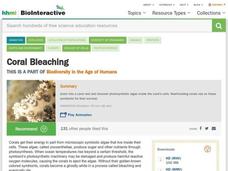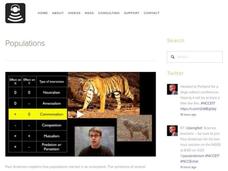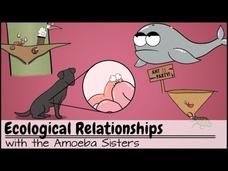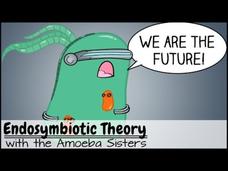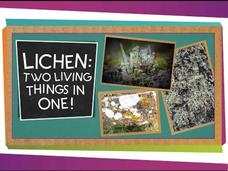FuseSchool
Ecology: What Is Mutualism
Sometimes different species work together to help each other out. This is known as mutualism.
Next Animation Studio
Climate change imperils French truffle production: scientists
Climate change-induced drier summers in France and Spain are damaging truffle harvests, according to a new study. Truffles are fungi that grow symbiotically with various tree species including beech, oak, hazel, and pine. Truffles thrive...
Mazz Media
Animal Essential Functions
This live-action video program is about the term "animal essential functions". The program is designed to reinforce and support a student's comprehension and retention of the term "animal essential functions" through use of video...
Journey to the Microcosmos
The Complicated Relationships of the Microcosmos
The Complicated Relationships of the Microcosmos
Professor Dave Explains
Endosymbiosis, Choanoflagellates, and the Origin of Animal Life
When we discuss zoology, we are always also talking about evolutionary biology. And with evolution, we are sometimes concerned with origins. What is the origin of animals? What is the origin of eukaryotes? What is the origin of life on...
Howard Hughes Medical Institute
Coral Bleaching
What is coral bleaching? Tackle a trendy topic with a narrated animation. Through a combination of video and illustration, the narrator introduces viewers to a coral reef, then goes inside a coral polyp to show its symbiotic relationship...
Bozeman Science
Populations
The largest concentration of free-roaming wildlife in the continental United States is found in Yellowstone National Park. A video describes the three main types of population interactions: mutualism, commensalism, and parasitism. It...
Bozeman Science
Evolutionary Significance of Cell Communication
Explore how cells communicate with a video that features the symbiotic relationship between a bioluminescent bacteria and the bobtail squid. The resource explains quorum sensing in bacteria and how epinephrin is linked to glycogen...
TED-Ed
You and Your Microbes
Humans are like planets, hosting a plethora of microbial communities. This concept is explored with vivid narration and animation, bringing to light the benefits of the huge variety of microbes that live in and on our bodies. What a fun...
Scholastic
Study Jams: Symbiosis
Three types of symbiosis are explained: parasitism, commensalism, and mutualism. This is done with colorful animation and lively dialogue in a straightforward and easy-to-follow manner. Have your ecology class watch this at home and then...
Curated OER
Populations
Every species in the world has some type of relationship with another species, whether it be positive, negative, or neutral for each party. Mr. Andersen defines each type of relationship and provides clear examples under each category....
Be Smart
Do Trees Talk?
Fungi could be considered the social network of the forest. A video lesson describes how fungi connect the plant species of the forest and create a symbiotic relationship. The episode from the It's Okay to be Smart series emphasizes the...
Bite Sci-zed
Mitochondrial DNA
Do young scientists know that some traits are only passed down by the mother? Mitochondrial DNA is an interesting phenomenon that provides researchers with a lot of useful information. Scholars learn about the endosymbiotic theory, what...
Amoeba Sisters
Ecological Relationships
What are ecological relationships? Well, it can be complicated! Paint a clear picture for pupils with a fun and informative video. It explains and illustrates each relationship thoroughly, from pesky parasites to snuggly symbiotes.
Amoeba Sisters
Endosymbiotic Theory
Eukaryotes—were we born from an act of predation that backfired? Ponder this and other questions of evolution with a video from a well-written biology playlist. Topics include the origins of mitochondria and chloroplasts, unusual...
Crash Course
The Evolutionary Epic: Crash Course Big History #5
In the timeline of history, Stegosaurus and Tyrannosaurus rex lived further apart from each other than Tyrannosaurus rex and humans. The fifth Crash Course-Big History video in a series of 16 introduces the concept of evolution. It...
Teacher's Pet
Species Interactions
Every species competes for food. The video explains interspecific competition, intraspecific competition, and the competitive exclusion principle as a part of predator-prey relationships. It also covers resource partitioning and the...
SciShow Kids
Lichen: Two Living Things In One
What do fungus and algae create? Lichen! Discover where lichen lives, how it survives, and how to find the three main types of lichen in a video all about lichen!
Be Smart
The Most Important Moment in the History of Life
Scholars learn about the first endosymbiosis, which lead to the production of the first organelle, mitochondria that are able to change shape, divide, reproduce, or grow larger, providing what is needed by a cell. The rest of the...
Bozeman Science
Communities
What do you get if you cross ants with ticks? All kinds of antics! Video discusses the structure of the classifications in ecology. Then it covers the ways communities can be measured before discussing an example of leaf cutter ants...
Bozeman Science
Endosymbiosis
If life on Earth began as a prokaryote, how did eukaryotic cells arise? Learners explore the history of endosymbiosis from Dr. Lynn Margulis' first writings, which were not widely received to the evidence of mitochondrial DNA. They then...
Be Smart
Can Coral Reefs Survive Climate Change?
Quick ... name an organism that's an animal, a vegetable, and a mineral. PBS Digital Studios models for viewers the symbiotic relationship between coral reefs zooxanthellae. The video then goes on to explain how climate change has...
Curated OER
Competition, Predation, and Symbiosis
Each biome has self sustaining communities, but how did these unique and stable communities form? Investigate how these evolved with changing animal interactions.
PBS
Pbs: Cold Warriors: Wolves and Buffalo
Explore the relationship between buffalo and wolves in the North American plains with this wildlife video! Join filmaker Jeff Turner as he follows one pack of wolves observing how they live together with the buffalo. [53:10]

